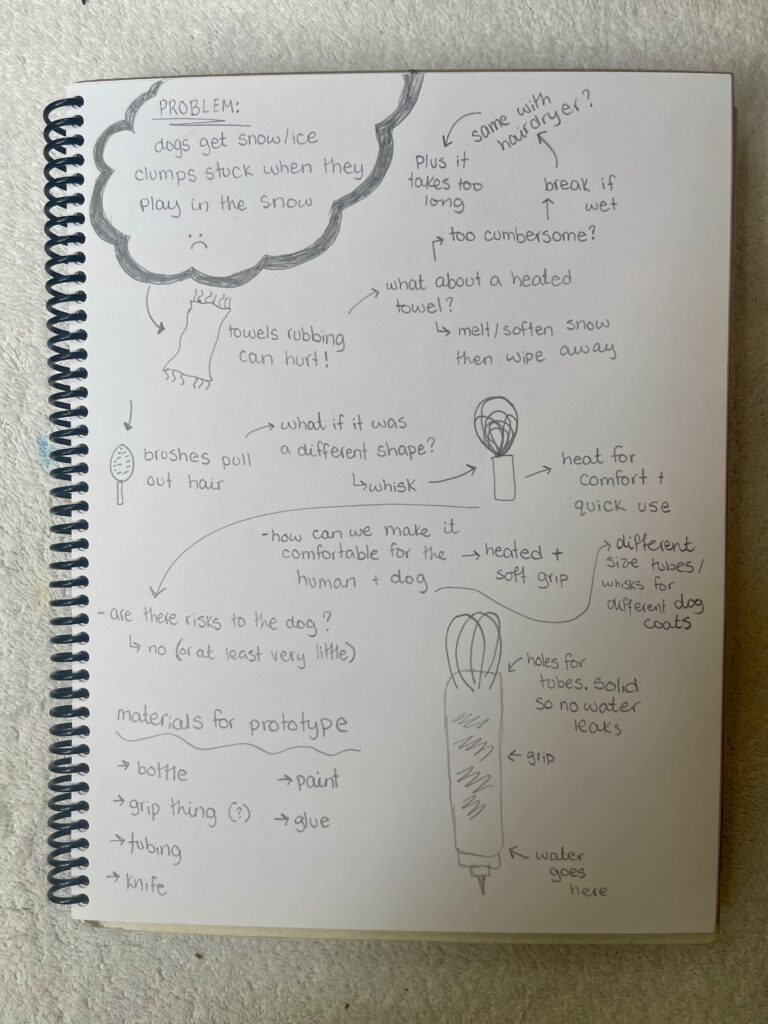Design Challenge
Well, here we are—the fourth and final project! My last task was to design my challenge and create a prototype. I started by identifying a challenge and generating some solutions, then moved on to creating a storyboard and prototype!
Below are my final prototype, process work, storyboard, and written reflection.


The problem I identified, why I chose it, and its significance.
Many dog owners, including myself, often struggle with snow and ice balls forming on our dogs’ legs during winter walks. These compacted clumps of snow and ice are particularly common in dogs with longer or curly hair. Unfortunately, they can be quite uncomfortable, sometimes even causing pain as they pull at the fur. This is a problem I’ve encountered personally with my dog Willow, and I’ve often felt unsure of how to help. Simply rubbing with a towel doesn’t solve the issue, and I have noticed that this can even worsen the discomfort. I chose to address this problem because I know it’s a common challenge for both pets and their owners. As an animal lover, I wanted to create something that would benefit not just humans but also our beloved companions.
The understanding that I used to connect the problem to my audience.
As I began exploring solutions to this issue, I contacted other dog owners to hear about their experiences with those troublesome snowballs. A few of my family friends shared their stories, expressing frustration that they still hadn’t found an effective solution. Some mentioned using a hairdryer to melt the snow but found it to be more time-consuming than it should be. Others tried putting their dogs in a warm bath, but this method was messy and inconvenient. Through these conversations, we bonded over our shared love for animals and commitment to making their lives as comfortable as possible.
The breadth of research into both what already exists and potential approaches for addressing this problem.
Traditional methods like using warm water, towels, or hairdryers can be messy and time-consuming. You end up with wet floors and a damp dog who’s not happy with the process, and it requires a lot of patience from both of you. Even after all that effort, some of those stubborn snowballs often stick around, no matter how many times you try to remove them.
While looking into alternatives, I found that some dog owners have tried specialized brushes or combs, but they usually require several passes and can be uncomfortable for the dog. Others have gone for protective dog booties to prevent snowballs from forming, but not all dogs are fans of wearing them, and they can be tricky to keep on during playtime.
One idea that really caught my attention was using a whisk or a tool with similar properties. It could break up the snowballs without pulling on the fur, making it quick, gentle, and less messy. My goal was to explore what’s already been tried and develop a practical and dog-friendly solution.
Ideas I generated.
When thinking of ways to remove those pesky ice and snowballs from dogs’ legs, I came up with a few ideas focusing on being easy to use and comfortable for both the dog and the owner. One idea is a heated whisk, which could gently melt and whisk away the snow without tugging at the fur. Another is a heated towel that wraps around the dog’s legs to melt the snow gradually, which is much less messy than a water bath. I also thought about a roller, like a lint roller, to quickly pick off the snowballs and a regular hairbrush with special bristles to gently brush them out. These ideas offer different approaches to make snow removal quicker and less stressful for everyone involved.
How peer feedback aided in the refining of my design.
Peer feedback was incredibly valuable in refining my design, and I incorporated insights from both my classmates and the friends and family I consulted with. The positive responses from the discussion post were really encouraging, showing that others struggle with this issue too and are eager for a better solution for their furry friends.
Through feedback, I also learned why certain ideas, like a roller or brush, might not be the best options. My friends pointed out that a roller could quickly become clogged with snow and fur, making it ineffective and difficult to clean. Similarly, while a special brush might seem familiar, it could still tug on the fur and cause discomfort, which defeats the purpose.
The collective feedback helped me to think more critically about my design choices and focus on creating a solution that truly addresses the problem without introducing new issues. It reminded me just how important it is to get input from a variety of people who understand the problem, as it really helps refine and improve the final design.
What I learnt from the process.
This process taught me that prototyping is tough, especially when you’re doing it mostly on your own with just a bit of feedback from others. Watching the IDEO Shopping Cart Project, where they worked together, splitting into groups and combining the best ideas, really made me appreciate the value of collaboration in this kind of work. It’s so helpful to have multiple perspectives contributing to a project.
I also realized how much material and resource constraints can impact the process. You have to work with what you’ve got, which can be frustrating but also forces you to get creative. Iteration was crucial in my design process, and I needed to remain flexible during changes. I would have loved to create multiple prototypes if I had more time because while working, I noticed things I’d do differently next time. Initial prototypes often reveal unexpected challenges or areas for improvement, so going through multiple iterations is key to arriving at a final, functional design.
Brainstorming & storyboard


